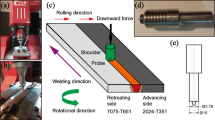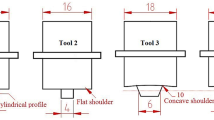Abstract
One of the advantages of friction stir welding process is its ability to join dissimilar metals and alloys. The aim of this work is to predict mechanical properties, i.e., tensile strength, hardness, and elongation of aluminum 6061 to aluminum 5010 joint that is fabricated by friction stir welding process. Here, response surface methodology based on central composite design with three parameters, five levels, and 20 runs was used to conduct experiments and to develop mathematical regression models. The three welding parameters considered were tool rotary speed, welding speed, and plunging depth. Analysis of variance was then performed to check the adequacy of developed models. The effects of process factors on mechanical properties were studied using developed mathematical models and on the basis of macrostructure and microstructure characterization and fractography of joints which are examined by optical and scanning electron microscopy. Finally, optimal parameter setting was identified by performing optimization through desirability approach function.
Similar content being viewed by others
References
Koilraj M, Sundareswaran V, Vijayan S, Rao SK (2012) Friction stir welding of dissimilar aluminum alloys AA2219 to AA5083—optimization of process parameters using Taguchi technique. Mater Des 42:1–7
Elangovan K, Balasubramanian V (2008) Influences of tool pin profile and axial force on the formation of friction stir processing zone in AA6061 aluminium alloy. Int J Adv Manuf Technol 38:285–295
Elangovan K, Balasubramanian V, Babu S (2009) Predicting tensile strength of friction stir welded AA6061 aluminum alloy joints. Mater Des 30:188–193
Lee WB, Yeon YM, Jung SB (2004) Mechanical properties related to micro structural variation of 6061 Al alloy joints by friction stir welding. Mater Trans 45(5):1700–1705
Ramalu PJ, Narayanan RG, Kailas SV, Reddy J (2013) Internal defect and process parameter analysis during frictio n stir welding of Al 6061 sheets. Int J Adv Manuf Technol 65:1515–1528
Yong-Jai KWON, Seong-Beom S, Dong-Hwan PARK (2009) Friction stir welding of 5052 aluminum alloy plates. Trans Nonferrous Metals Soc China 19:s23–s27
Min-Su HAN, Seung-Jun LEE, Jae-Cheul PARK, Seok-Cheol KO, Yong-Bin WOO, Seong-Jong KIM (2009) Optimum condition by mechanical characteristic evaluation in friction stir welding for 5083-O Al alloy. Trans Nonferrous Metals Soc China 19:s17–s22
Moshwan R, Yusof F, Hassan MA, Rahmat SM (2015) Effect of tool rotational speed on force generation, microstructure and mechanical properties of friction stir welded Al–Mg–Cr–Mn (AA 5052-O) alloy. Mater Des 66:118–128
Aval HJ, Serajzadeh S, Kokabi AH (2011) Thermo-mechanical and microstructural issues in dissimilar friction stir welding of AA5086–AA6061. J Mater Sci 46(10):3258–3268
Alvarez P, Arruti E, Aldanondo E, Alberto E (2012) Understanding material flow in FSW and its implications. Proceedings of the second international conference FSWP’2012, ISBN: 978-2- 911256-72-1, France
Palanivel R, Mathews PK, Murugan N, Dinaharan I (2012) Effect of tool rotational speed and pin profile on microstructure and tensile strength of dissimilar friction stir welded AA5083-H111 and AA6351-T6 aluminum alloys. Mater Des 40:7–16
Leitao C, Louro R, Rodrigues DM (2012) Analysis of high temperature plastic behavior and its relation with weldability in friction stir welding for aluminum alloys AA5083–H111 and AA6082–T6. Mater Des 37:402–409
Kasman Ş (2013) Multi-response optimization using the Taguchi-based grey relational analysis: a case study for dissimilar friction stir butt welding of AA6082-T6/AA5754-H111. Int J Adv Manuf Technol 68(1–4):795–804
Zhang Z (2008) Comparison of two contact models in the simulation of friction stir welding process. J Mater Sci 43(17):5867–5877
Zhang Z, Chen TJ (2012) Computational investigations on reliable finite element-based thermomechanical-coupled simulations of friction stir welding. Int J Adv Manuf Technol 60:959–975
Zhang Z, Zhang HW (2014) Solid mechanics-based Eulerian model of friction stir welding. Int J Adv Manuf Technol 72:1647–1653
Zhang Z, Chen TJ, Zhang ZW, Zhang HW (2011) Coupled thermo-mechanical model based comparison of friction stir welding processes of AA2024-T3 in different thicknesses. J Mater Sci 46:5815–5821
Zhang Z, Wu Q, Gruijicic M, Wan ZY (2015) Monte Carlo simulation of grain growth and welding zones in friction stir welding of AA6082-T6. J Mater Sci. doi:10.1007/s10853-015-9495-x
Zhang Z, Wu Q, Zhang HW (2015) Prediction of fatigue life of welding tool in friction stir welding of AA6061-T6. Int J Adv Manuf Technol. doi:10.1007/s00170-016-8475-x
Aval HJ, Serajzadeh S, Kokabi AH (2012) Experimental and theoretical evaluations of thermal histories and residual stresses in dissimilar friction stir welding of AA5086-AA6061. Int J Adv Manuf Technol 61:149–160
Al-Badour MN, Shuaib A, Bazoune A (2014) Thermo-mechanical finite element model of friction stir welding of dissimilar alloys. Int J Adv Manuf Technol 72:607–617
Kishore VR, Arun J, Padmanabhan R, Balbasubramanian V (2015) Parametric studies of dissimilar friction stir welding using computational fluid dynamics simulation. Int J Adv Manuf Technol 80:91–98
Padmanaban R, Balusamy V, Saikirishna V, Gopath NK (2014) Simulated annealing based parameter optimization of friction stir welding of dissimilar aluminum alloy. Procedia Engineering 97:864–870
Elatharasna G, Senthil Kumar VS (2012) Modeling and oprimiation of friction stir welding parameters for dissimilar aluminum alloys using RSM. Procedia Engineering 38:3477–3481
Gupta SK, Pandey KN, Kumar R (2016) Multi-objective optimization of friction stir welding process parameters for joining of dissimilar AA5083/AA6063 aluminum alloys using hybrid approach. Proceedings of the Institution of Mechanical Engineers, Part L: Journal of Materials Design and Applications, 1464420715627294
Palanivel R, Mathews PK, Murugan N (2013) Optimization of process parameters to maximize ultimate tensile strength of friction stir welded dissimilar aluminum alloys using response surface methodology. J Cent South Univ 20(11):2929–2938
Arora A, Nadan R, Reynolds AP, Debroy T (2009) Torque, power requirement and stir zone geometry in friction stir welding through modeling and experiments. Scr Mater 60:13–16
Shayan AV, Azar Afza R, Teimouri R (2013) Parametric study along with selction of optimal solutions in dry wire cut machining of cemented tungsten carbide (WC-Co). J Manuf Process 15(4):644–658
Babajanzade-Roshan S, Behboodi-Jooibari M, Teimouri R, Asgharzade-Ahmadi G, Falahati-Naghibi M, Sohrabpoor H (2013) Optimization of friction stir welding process of AA7075 aluminum alloy to achieve desirable mechanical properties using ANFIS models and simulated annealing algorithm. Int J Adv Manuf Technol 69(5):1803–1818
Elangovan K, Balasubramanian V (2007) Influences of pin profile and rotational speed of the tool on the formation of friction stir processing zone in AA2219 aluminium alloy. Mater Sci Eng A 459(1):7–18
Author information
Authors and Affiliations
Corresponding author
Rights and permissions
About this article
Cite this article
Ahmadnia, M., Shahraki, S. & Kamarposhti, M.A. Experimental studies on optimized mechanical properties while dissimilar joining AA6061 and AA5010 in a friction stir welding process. Int J Adv Manuf Technol 87, 2337–2352 (2016). https://doi.org/10.1007/s00170-016-8636-y
Received:
Accepted:
Published:
Issue Date:
DOI: https://doi.org/10.1007/s00170-016-8636-y




